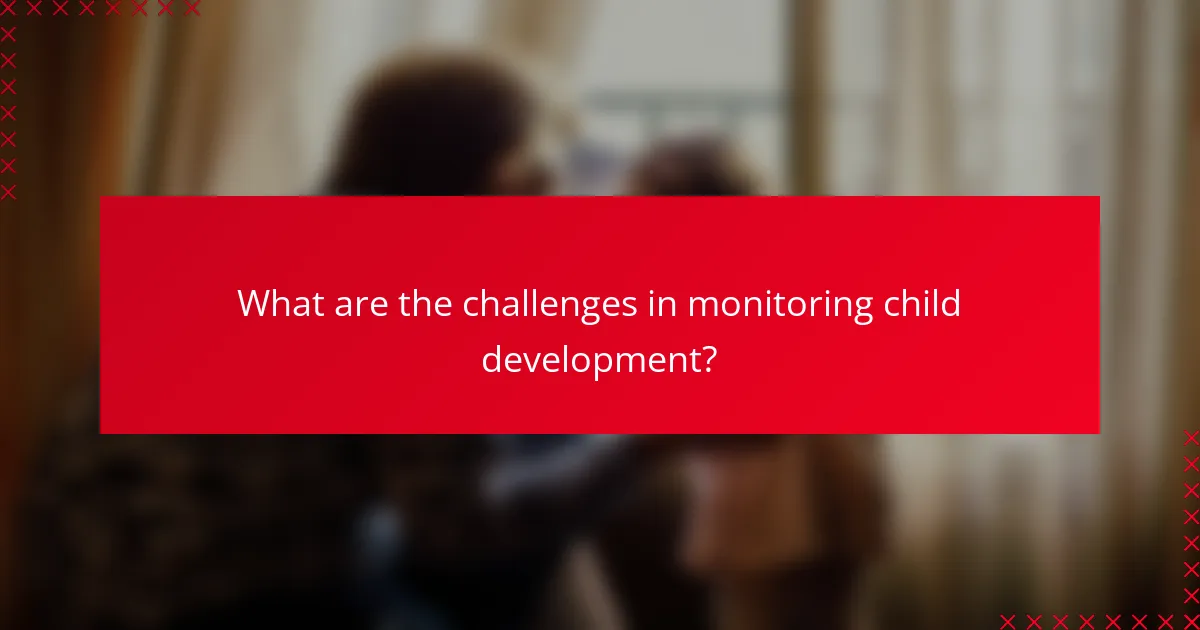Monitoring child development is essential for ensuring that children reach their growth milestones effectively. Utilizing a variety of tools and strategies, such as developmental screenings and mobile apps, parents and caregivers can track progress and identify any potential delays. By fostering skills through positive interactions and structured activities, they can support their child’s cognitive, emotional, and social development.

How to monitor child development in the United States?
Monitoring child development in the United States involves using various tools and strategies to assess a child’s growth and milestones. Parents and caregivers can utilize developmental screenings, observational techniques, and professional assessments to ensure their child is on track.
Developmental screening tools
Developmental screening tools are standardized instruments designed to evaluate a child’s growth in specific areas such as language, motor skills, and social-emotional development. Common tools include the Ages and Stages Questionnaire (ASQ) and the Denver Developmental Screening Test.
These screenings typically occur during routine pediatric visits, often at 9, 18, and 24 months, with follow-ups at 3 and 4 years. They help identify children who may need further evaluation or early intervention services.
Parental observation techniques
Parents can play a crucial role in monitoring their child’s development through careful observation. Keeping a developmental journal can help track milestones and behaviors, noting when a child achieves skills like walking or speaking their first words.
Engaging in activities that promote development, such as reading together or playing interactive games, allows parents to observe their child’s progress in real-time. Regularly discussing concerns with pediatricians can also ensure that any developmental delays are addressed promptly.
Professional assessments
Professional assessments involve evaluations conducted by specialists, such as child psychologists or speech therapists, to gain a comprehensive understanding of a child’s development. These assessments may include standardized tests and observational methods tailored to the child’s age and needs.
In the U.S., early intervention programs often provide these services for children under three years old who show signs of developmental delays. Parents should be proactive in seeking these assessments if they notice any concerns, as early intervention can lead to better outcomes.
![]()
What tools are effective for tracking child development?
Effective tools for tracking child development include mobile apps, growth charts, and developmental milestone checklists. These resources help parents and caregivers monitor progress, identify potential delays, and ensure children meet key developmental benchmarks.
Apps for child development tracking
Child development tracking apps provide a convenient way to log milestones, behaviors, and growth patterns. Many apps offer reminders for developmental checks and provide resources tailored to specific age groups.
Popular options include Baby Connect, Wonder Weeks, and Growth: Baby & Child Tracker. When choosing an app, consider user reviews, ease of use, and whether it aligns with your tracking needs.
Growth charts from the CDC
The CDC provides growth charts that help track children’s height, weight, and body mass index (BMI) against national averages. These charts are essential for assessing whether a child is growing at a healthy rate compared to peers.
Parents can access these charts online and plot their child’s measurements to visualize growth trends. Regularly updating this information can help identify any potential health concerns early.
Developmental milestone checklists
Developmental milestone checklists outline key skills and behaviors that children typically achieve at various ages. These checklists serve as a practical guide for parents to assess their child’s progress in areas such as motor skills, language, and social interactions.
Common resources for these checklists include the CDC’s “Milestone Tracker” and the American Academy of Pediatrics. Regularly reviewing these milestones can help parents spot delays and seek appropriate support when necessary.

What strategies can support child development?
Effective strategies for supporting child development focus on fostering skills through positive interactions, structured activities, and active parental involvement. These approaches can enhance cognitive, emotional, and social growth in children.
Positive reinforcement techniques
Positive reinforcement involves rewarding desirable behaviors to encourage their repetition. This can include verbal praise, small rewards, or extra playtime when a child exhibits good behavior or achieves a developmental milestone.
To implement positive reinforcement effectively, be specific about what behavior you are praising. For example, instead of saying “good job,” you might say, “I love how you shared your toys with your friend.” This clarity helps children understand what actions are valued.
Structured play activities
Structured play activities provide children with guided opportunities to learn and develop skills in a fun environment. These can include games that promote teamwork, problem-solving, or physical coordination, such as building blocks or group sports.
When planning structured play, consider the age and interests of the child. Activities should be engaging yet challenging enough to stimulate growth. For instance, a simple game of Simon Says can enhance listening skills and following directions.
Parental involvement strategies
Active parental involvement is crucial for supporting child development. This can include participating in educational activities, attending school events, or simply spending quality time reading together. Such engagement fosters a strong emotional bond and reinforces learning.
To maximize effectiveness, parents should establish a routine that includes dedicated time for interaction. For example, setting aside 20-30 minutes daily for reading or educational games can significantly impact a child’s development. Avoid distractions during this time to enhance focus and connection.

What are the key developmental milestones?
Key developmental milestones are specific skills or behaviors that children typically achieve at certain ages. Monitoring these milestones helps parents and caregivers assess a child’s growth and identify any potential developmental delays.
Milestones by age group
Developmental milestones vary across different age groups, with each stage marked by specific achievements. For instance, by 12 months, many children can stand alone and say simple words like “mama” or “dada.” By age 3, children often can run, climb, and engage in basic conversations.
It’s crucial to remember that while these milestones provide a guideline, children develop at their own pace. Regular check-ups with pediatricians can help track progress and address any concerns.
Social-emotional development indicators
Social-emotional development indicators include a child’s ability to interact with others and manage their emotions. By age 2, children typically show increased independence and may exhibit a range of emotions, such as joy, frustration, and anger.
By age 5, children usually develop friendships and begin to understand the concept of sharing and cooperation. Observing how a child plays with peers can provide insights into their social-emotional growth.
Cognitive development benchmarks
Cognitive development benchmarks refer to the mental skills children acquire as they grow. By 18 months, many children can point to objects when named and follow simple instructions. By age 4, they often can count to four and understand the concept of time, such as “yesterday” and “tomorrow.”
Parents can support cognitive development by engaging children in activities like reading, puzzles, and problem-solving games. Providing a stimulating environment encourages curiosity and learning.

How to choose the right developmental tools?
Selecting the right developmental tools involves considering the specific needs of the child, the tool’s effectiveness, and its alignment with developmental milestones. Tools should be age-appropriate, engaging, and backed by research to ensure they support growth in key areas such as cognitive, social, and emotional development.
Criteria for selecting tools
When choosing developmental tools, prioritize those that are evidence-based and have been validated through research. Look for tools that are designed for the child’s specific age group and developmental stage, ensuring they are neither too easy nor too challenging.
Consider the usability of the tool; it should be engaging for the child and easy for caregivers to implement. Additionally, check for any recommendations or endorsements from pediatricians or child development specialists, as these can provide valuable insights into the tool’s effectiveness.
Comparative analysis of popular tools
Popular developmental tools include apps, games, and physical toys. For instance, apps like “Endless Alphabet” and “ABCmouse” are designed to enhance literacy skills, while games like “Simon Says” promote social interaction and listening skills. Each tool has unique benefits, so consider what skills you want to target.
When comparing tools, evaluate factors such as cost, accessibility, and the type of feedback they provide. Some tools may offer free trials or have subscription models, which can influence your decision based on budget constraints. Always read reviews and seek recommendations from other parents or professionals to gauge the tool’s effectiveness in real-world settings.

What are the challenges in monitoring child development?
Monitoring child development involves various challenges, including access to resources, variability in developmental milestones, and parental awareness. These factors can significantly impact the effectiveness of tracking a child’s growth and identifying potential delays.
Access to resources
Access to resources is a critical challenge in monitoring child development. Many families may lack access to healthcare services, educational materials, or community programs that provide developmental screenings. This can lead to missed opportunities for early intervention, which is crucial for addressing developmental delays.
To improve access, families can seek local organizations or government programs that offer free or low-cost developmental assessments. Utilizing online resources and telehealth services can also bridge gaps in access, especially in rural areas where services may be limited.
Variability in child development
Variability in child development refers to the differences in how children grow and learn at different rates. Each child is unique, and factors such as genetics, environment, and culture can influence their developmental trajectory. This variability can make it difficult to determine what is considered “normal” development.
Parents and caregivers should familiarize themselves with typical developmental milestones, but they must also recognize that deviations from these milestones do not always indicate a problem. Regular check-ups with pediatricians can help monitor a child’s progress and provide guidance tailored to individual needs.
Parental awareness and education
Parental awareness and education play a vital role in effectively monitoring child development. Many parents may not be fully informed about the signs of developmental delays or the importance of early intervention. This lack of knowledge can hinder timely action when concerns arise.
To enhance awareness, parents should engage in educational programs or workshops focused on child development. Resources such as books, reputable websites, and community support groups can provide valuable information. Encouraging open communication with healthcare providers can also help parents stay informed about their child’s developmental health.
